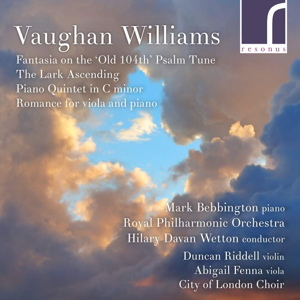
Ralph Vaughan Williams (1872-1958)
Piano Quintet in C minor (1903) [29]
The Lark Ascending, original version for violin and piano (1914) [13]
Romance for Viola and Piano (1914?) [7]
Fantasia (quasi variazione) on the ‘Old 104th’ Psalm Tune (1949) [16]
Mark Bebbington (piano), Duncan Riddel (violin), Richard Harwood (cello), Abigail Fenna (viola)
City of London Choir
Royal Philharmonic Orchestra/Hilary Davan Wetton
rec. 2022, St. John’s Smith Square, London, UK
Resonus RES10311 [65]
Vaughan Williams is not too well known for chamber music. He withdrew the piano quintet and other early pieces. Shortly after his death, his widow Ursula gave the manuscripts to the British Library. Given who his teachers were, it may be unsurprising that the two outer movements are redolent of Brahms; I struggled to spot indicators of the fully mature RVW, except for an obvious affection for the dusky tones of the viola. But they are attractive, and pianist Mark Bebbington plays with great fervour. When the assertive opening of the first movement relaxes, the music becomes quite lovely. Interestingly, the double bass replaces the second violin, and adds a supportive lower resonance to the sound. The last movement is a set of variations on a theme introduced on unison strings; RWV used the theme in the last movement of the late Violin Sonata of 1954. The slow movement opens with a tune on the piano. A distinct foretelling of “Silent Noon” from 1904, it permeates the movement, although the central part is more agitated and less distinctive.
This relatively early piece is very much worth hearing. It is beautifully played here, and really is essential listening for all lovers of RWV’s music.
When one is faced with yet another recording of The Lark Ascending, it is difficult to suppress a sigh of resignation. Still, sales matter, and the enduring popularity of the piece does not detract from its beauty. But here we have something rather different: the original version for violin and piano. RVW put the first draft on one side until the war was over, then he completed it and also created the much-loved orchestral version. Just before the lockdown, I had the pleasure of hearing Jennifer Pike and Martin Roscoe perform it at the Ribble Valley Piano Festival. I enjoyed it very much, just as I have done with this recording. Hearing it followed immediately by a recording of the standard version, I was immediately struck by how natural the orchestration is, and by the beauty and songfulness of this original. Duncan Riddell plays it very well, with excellent purity of tone.
The Romance for Viola and Piano was probably composed for Lionel Tertis just before the First World War. No record exists of a first performance from that time. It exists in two manuscripts, one in the composer’s hand and another in the hand of his first wife, Adeline. It is not a memorable creation. It is played lusciously here by Abigail Fenna, and rises to an impassioned climax, but its melody does not linger in my memory.
The Fantasia (quasi variazione) on the ‘Old 104th’ Psalm Tune has been recorded before, first in America in a reduced version for piano, organ and strings (review), and then in the present form (review). The latter (EMI) recording has been issued and reissued – and reviewed – several times as a filler for other works. I have listened to my CD, and I was not exactly thrilled at the thought of another version, but I need not have felt that way. The old performance hardly compares with this new version, either in the energy of commitment or recording quality. Everyone tackles the work with considerable gusto; it emerges from the loudspeakers with immense impact. There are three piano cadenzas. The first is introduced by low growls and percussion from the orchestra, which the piano matches with sonorous chords, superbly caught by the recording of Mark Bebbington’s muscular playing. The full theme gradually emerges from the piano, and leads into the orchestra and chorus intoning the words of the first verse. Both are given exemplary prominence in the recorded balance. The second cadenza is a reworking of the first to a different time signature, eventually taken up by the chorus for the second verse; that is followed by the third verse, this time treated by RVW as a fugue with thunderous orchestra and piano accompanying. This leads into the final cadenza, and the whole work ends with unison singing of the last verse, finishing up with most satisfying “Amens”.
Although I was educated at a state Grammar School where each morning’s assembly was conducted with at least one hymn accompanied by the organ, I do not remember the tune or the words. Vaughan Williams was, of course, uniquely qualified to judge the quality of the music that comprised Anglican Hymn Books. He has completely revised them for the 1907 issue of “The English Hymnal with tunes”, so he must have rated this one highly. The physical demands of the Fantasia must mitigate against its performance, comprising as it does just 16 minutes of music which necessitates large chorus, a pianist and full orchestra. Perhaps it could best be done together with one of his cantatas – it would bring the house down!
The performance and recording of all four works are superb in every respect. Resonus have produced this disc to the highest standards. The booklet contains thorough descriptions of the music and biographical information appertaining to the performers. The recording was sponsored by The Vaughan Williams Charitable Trust.
Jim Westhead
Help us financially by purchasing from




















